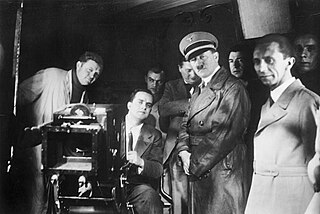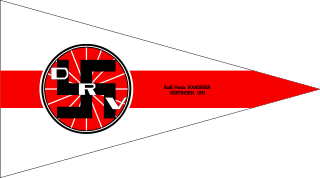Emblem of the
Reichsbund der Deutschen Beamten (RDB), from
Organisationsbuch der NSDAP 1943The Reichsbund der Deutschen Beamten (RDB), meaning "Reich Federation of German Civil Servants", also known as NS-Beamtenbund (National Socialist Civil Servants Federation), was the trade union for German State Officials during the Third Reich. The RDB was established as an organization affiliated to the Nazi party in October 1933. Its leader was Herman Neef. Neef had been previously leading the RDB's predecessor organisation, Deutscher Beamtenbund German Civil Service Federation, which had been founded in December 1918.
Although it was not compulsory for RDB members to be Nazi party members, most of them chose to be. In addition to the training and development of its members, the RDB ensured that German Civil Servants toed the line of the Nazi Party. [1]
Following Nazi Germany's defeat in World War II, the American Military Government issued a special law outlawing the Nazi party and all of its branches. Known as "Law number five", this denazification decree disbanded the National Socialist Civil Servants Federation, like all other organizations linked to the Nazi Party. In the postwar years, it was reestablished as the German Civil Service Federation in the Federal Republic of Germany.

Gleichschaltung, or in English co-ordination, was in Nazi terminology the process of Nazification by which Adolf Hitler and the Nazi Party successively established a system of totalitarian control and coordination over all aspects of German society and societies occupied by Nazi Germany "from the economy and trade associations to the media, culture and education".

The National Socialist German Workers' Party, commonly referred to in English as the Nazi Party, was a far-right political party in Germany that was active between 1920 and 1945, that created and supported the ideology of National Socialism. Its precursor, the German Workers' Party, existed from 1919 to 1920.

Hans Josef Maria Globke was a German lawyer, high-ranking civil servant and politician who was Under-Secretary of State and Chief of Staff of the German Chancellery in West Germany from 28 October 1953 to 15 October 1963. During World War II, Globke, a Ministerialdirigent in the Office for Jewish Affairs in the Ministry of the Interior, wrote a legal annotation on the anti-semitic Nuremberg Race Laws that did not express any objection to the discrimination against Jews, and placed the Nazi Party on a firmer legal ground, setting the path to The Holocaust. Globke later had a controversial career as Secretary of State and Chief of Staff of the West German Chancellery. In this role he was responsible for running the Chancellery, recommending the people who were appointed to roles in the government, coordinating the government's work, and for the establishment and oversight of the West German intelligence service and for all matters of national security.

Otto Johann Maximilian Strasser was a German politician and an early member of the Nazi Party. Otto Strasser, together with his brother Gregor Strasser, was a leading member of the party's left-wing faction, and broke from the party due to disputes with the dominant "Hitlerite" faction. He formed the Black Front, a group intended to split the Nazi Party and take it from the grasp of Hitler. This group also functioned during his exile and World War II as a secret opposition group.

Wilhelm Stuckart was a German Nazi Party lawyer, official and a state secretary in the Reich Interior Ministry during the Nazi era.
This is a list of words, terms, concepts and slogans of Nazi Germany used in the historiography covering the Nazi regime. Some words were coined by Adolf Hitler and other Nazi Party members. Other words and concepts were borrowed and appropriated, and other terms were already in use during the Weimar Republic. Finally, some are taken from Germany's cultural tradition.
In the thirteen years the Weimar Republic was in existence, some forty parties were represented in the Reichstag. This fragmentation of political power was in part due to the peculiar parliamentary system of the Weimar Republic, and in part due to the many challenges facing German democracy in this period.

The flag of Nazi Germany, officially the flag of the German Reich, featured a red flag with the swastika on a white disc. This flag came into use initially as the banner of the National Socialist German Workers Party (NSDAP) after its foundation. Following the appointment of Adolf Hitler as Chancellor in 1933, the flag was adopted as the one of the nation's dual national flags, the other being the black-white-red horizontal tricolour of the German Empire.

Hans von Tschammer und Osten was a German sport official, SA leader and a member of the Reichstag for the Nazi Party of Nazi Germany. He was married to Sophie Margarethe von Carlowitz.

The NSDAP/AO was the foreign organization branch of the National Socialist German Workers Party (NSDAP). AO is the abbreviation of the German compound word Auslands-Organisation. Although it would be correctly written in one word, the Nazis chose an obsolete spelling with a hyphen.

Nazism created an elaborate system of propaganda, which made use of the new technologies of the 20th century, including cinema. Nazism courted the masses by the means of slogans that were aimed directly at the instincts and emotions of the people. The Nazis valued film as a propaganda instrument of enormous power. The interest that Adolf Hitler and his propaganda minister Joseph Goebbels took in film was not only the result of a personal fascination. The use of film for propaganda had been planned by the National Socialist German Workers Party as early as 1930, when the party first established a film department.
The term Hitler oath — also often referred to in English as simply the Soldier's Oath or Soldiers' Oath — refers to the oaths of allegiance, sworn by the officers and soldiers of the German Armed Forces and civil servants of Nazi Germany between the years 1934 and 1945. The oath pledged personal loyalty to Adolf Hitler in place of loyalty to the constitution of the country.

Reichsbund jüdischer Frontsoldaten was an organization of German Jewish soldiers founded in February 1919 by Leo Löwenstein to demonstrate Jewish loyalty to the Reich.

The Reichskommissariat Niederlande was the civilian occupation regime set up by Germany in the German-occupied Netherlands during World War II. Its full title was the Reich Commissariat for the Occupied Dutch Territories. The administration was headed by Arthur Seyss-Inquart, formerly the last chancellor of Austria before initiating its annexation by Germany.

The National Socialist League of the Reich for Physical Exercise, was the umbrella organization for sports and physical education in Nazi Germany. The NSRL was known as the German League of the Reich for Physical Exercise until 1938. The organization was expanded to Austria after that country's annexation by Nazi Germany.

The Kyffhäuserbund is an umbrella organization for war veterans' and reservists' associations in Germany based in Rüdesheim am Rhein. It owes its name to the Kyffhäuser Monument, a memorial built on the summit of the 473 m high Kyffhäuser mountain near Bad Frankenhausen in the state of Thuringia in central Germany.

The Deutscher Radfahrer-Verband (DRV), "German Cycling Association", was the cycling unit of the National Socialist League of the Reich for Physical Exercise.

Reichsbund der Kinderreichen (RDK) or (RdK), Reich's Union of Large Families or, literally: "Reich's League of those wealthy in children", was one of the most important pronatalist groups founded in Germany after World War I. To qualify as a member of this league a family should have at least four children. Widows were also admitted.

Bank of German Labor, Inc. was a financial institution of the German Labor Front (DAF). Founded in 1924 as the Bank of Workers, Employees, and Civil Servants by organizations representing these groups, the Berlin-based bank was taken over by the DAF and renamed after the National Socialists nationalized, all independent trade unions on May 2, 1933, and put them under state ownership, similar to what Vladimir Lenin had decreed in Soviet Russia.

Oskar Georg Fischbach was a German lawyer and civil servant who was involved in drafting the civil service law at the end of the Weimar Republic and various official laws of Nazi Germany.















